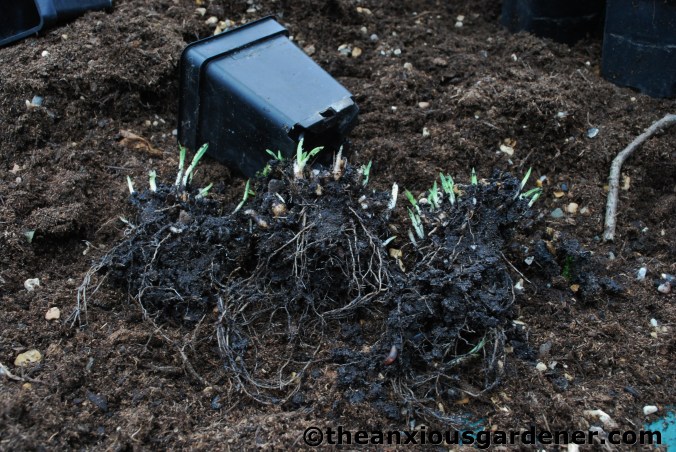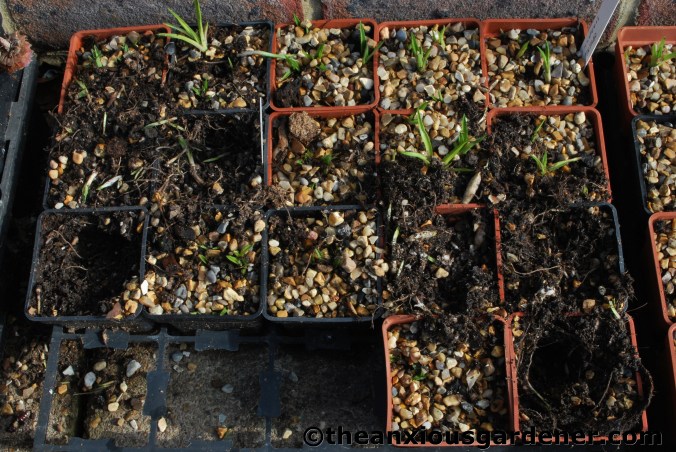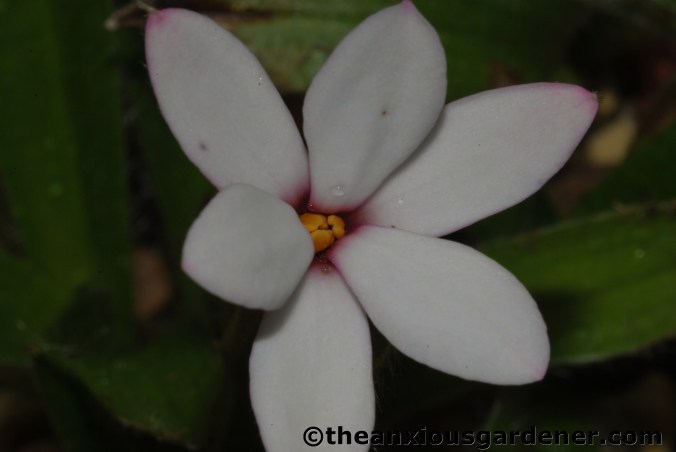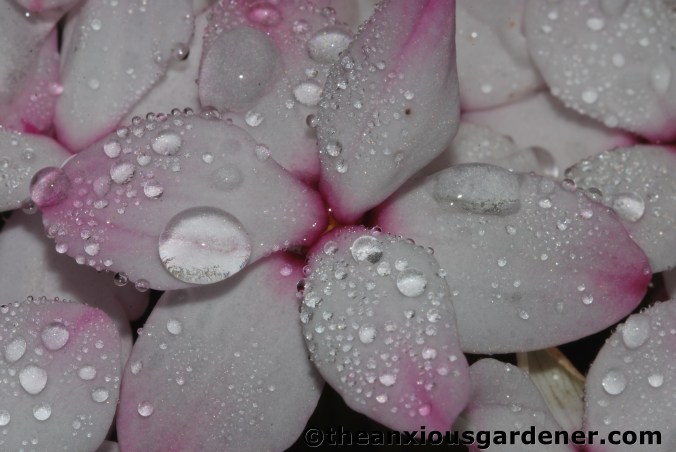I have a silly number of rhodohypoxis but, in my defence, I was smitten when I first saw them. I was working at an alpine nursery and watched entranced as hundreds and hundreds of 6cm pots burst into flower; crammed full of red, pink and white flowers.
They flower for weeks on end and are pretty easy to look after. Keep on dead-heading (the spent flowers come away easily) and water regularly throughout spring and summer. Planted in well draining beds or in terracotta pots they make a great, long-lasting show, quickly increase in number and seem to pique people’s interest. But surprisingly (at least in my experience) they are not widely known.
In autumn, I put all my pots under the greenhouse staging and stop watering completely. After a few weeks the dried, dead growth pulls away freely and they can then be left undisturbed until March, when I start infrequent watering again. By early April new leaves begin to emerge:
Now is the time to increase your stock. Propagation by division is straight-forward: knock out each plant and divide into two or three – the corm-like tubers separate easily –
and re-pot using ericaceous compost (if you use it). I don’t and they seem to thrive in anything other than alkaline soil.
Top dress with gravel, put them outside, protect against mice
– or, like me, don’t protect against mice – throw a tantrum, pop a patience pill and wait for them to flower. It won’t be long.
I put these in the cold frame just to keep the rodents off ; they haven’t all started flowering yet but many are under way.
I have about ten varieties: this is ‘Tetra Red‘;
here is ‘Candy Stripe‘;
and my favourite, ‘Hebron Farm Red Eye‘ – a pink-tinged white with golden centre. (Pedant’s Corner: strictly speaking this is a x Rhodoxis)
‘Picta‘ is a another white
which looks lovely en masse, with its pink blush. Can you tell it’s still raining in Sussex?
R. ‘Fred Broome‘ may fade a little if left all day in full sun
and here’s one of my newer acquisitions – ‘Pintado.’ Similar but a little shorter than ‘Candy Stripe.’
So, yes, as I said, I’m pretty smitten by this beautiful little plant, originally from the Drakensburg mountains in South Africa. And why do I have so many? Because I keep on propagating them! I give them away as gifts – which are always well received – and I used to sell them on a little stall outside my house, with other choice little alpines. But now I plan to plant them out into a raised, sharply draining bed at the Priory – and make up some more pots. And if the pesky, pernicious, pilfering, pestiferous podents rodents don’t get them, they should look mighty fine.
So, rhodohypoxis. Have I convinced you? Are you smitten too?














Thank you David. I had no idea these need ericaceous compost or when to divide, as I guessed that’s the way to increase. I discovered these at the wonderful alpine show in Wymondham Norfolk about 3 years ago. They are now one of my favourites. I haven’t had mouse problems but this year I have some young mallard thugs who I caught having a go at them after they had completely demolished my Begonias.
LikeLiked by 1 person
Hi, they are a nice discovery to have made – and no, I had no mice problem this year. Nor indeed a mallard problem which is just as well as we have plenty of ducks about the place. Division is easy and will rapidly increase your stock. I’m forever giving some away as I have so many. Dave
LikeLike
I’ve just discovered these in Hillier’s, a “new strain” called Goliath, are they ericaceous? Lovely plants.
I enjoyed your blog David, thank you
Carol from Berkshire
LikeLiked by 1 person
Hi Carol, rhodohypoxis should be potted with ericaceous compost but I have used ordinary compost too (by mistake) and barely noticed the difference. And thanks! Very glad you like my blog.
LikeLike
I have only just discovered these exquisite plants – I fell in love at first sight when I visited Inverewe Gardens near Gairloch (W coast of Scotland). I found some for sale online and now hope to do some troughs for them because I have run out of space in my rock garden.
LikeLike
Hi Terry, they are exquisite aren’t they? This post is three years old and since I wrote it, I now have twice the number of rhodohypoxis pots and pans which I dot about the Priory when in flower. For a few weeks they do look glorious. Dave
LikeLiked by 1 person
Well, I continue to grow mine outside – some do well and spread; some just disappear. I’m probably up to about five varieties now which survive all that winter throws at them. The huge advantage for a scree bed is that they go on flowering long after most alpines are over. The disadvantage is that they come into growth late, so are always in danger from the spring weed, since I never remember where they are…
LikeLike
I could send you some more varieties, Mr K if you like. I have far too many and will happily post them in winter when they’re dormant. D
LikeLike
Thanks, David – always glad of a few more! Choose the toughest ones you have though…’Hebron Farm Biscuit’ has yet again failed to appear (that’s 3 attempts now)
LikeLike
Hmm. Not sure I can select ‘tough’ ones, Mr K as all mine seem to perform similarly here in the Deep South. I’ve had some problems with fading labels but I’ll send you a selection and we’ll see how they get on in those ‘Edge’ conditions of yours D.
LikeLike
Pingback: Five rock plants for June | Gardening At The Edge
Your post makes for a handy guide in growing these beautiful alpine plants! I like the way they look in those square containers too 🙂
LikeLiked by 1 person
Glad you like ’em, Boys. They are peachy! D
LikeLike
Hi Dave, I have no idea why you disappeared from my blog list. WordPress does do some strange things sometimes. Gremlins at work I guess. You have now returned though. Best wishes WW
LikeLike
That’s absolutely fine, WW – like I said I was a little worried that I may have upset you and you’d thought, “Right!”
LikeLike
Well worth the wait, Dave. Yes, already, I’m smitten.
LikeLike
Good for you, Mr F. Great taste. D
LikeLike
I must admit, dear Dave, that I’m not smitten indeed. I don’t normally fall for little things (and please don’t comment this phrase other than gardening meaning), but they are very very pretty (did I mention very?). It would be nice to see a tapestry of these tiny little candies in some mountain in South Africa.
Do you think a couple of your mice are getting married and maybe they need something to embellish their little mouse church?
LikeLike
You been on the afternoon grappa again, Alberto? I don’t think mice have churches actually. Sorry the rhodos didn’t float your boat but, yes I should love to see them in the wild. D
LikeLike
You’ve convinced me. I don’t think I’ve ever seen them before and they’re beautiful. I love alpines, they were some of the first plants I bought when I was a child. One day I will get round to creating a proper space for them. At present they just sit in a variety of pots on a table in my back garden but they deserve something better. I never seem to get round to it… maybe I should devote more time to my garden and stop this blogging! I often whinge about the multitude of cats in my village but I guess at least they keep the rodent population down.
LikeLike
Luckily no cats at the Priory at all – which pleases me no end. I often wonder how much more gardening I could get done if I didn’t blog! D
LikeLike
I’ve been smitten by these since I came across them for sale at Gardening Scotland a few years back, Dave. Mine are in flower (only 3 varieties) but they are not looking as healthy as last year. Maybe I should have split them?
LikeLike
Some of my larger pots have been un-split for about three years, Janet – next year I will split and repot. Yours may be a little congested? D
LikeLike
It maybe that. The foliage looks a bit yellowed too and they flowered last year prolifically!
I’ll give it a go…
LikeLike
I can’t believe I’ve not come across these. You’ve convinced me – easy things in pots I can pop in a corner to brighten it are always useful. I’ll have to see if I can find some. 🙂
LikeLike
That’s how I use them, Libby – moving pots about as needed. D
LikeLike
Never heard of this plant, but it is very pretty. They look adorable in that last picture. Now I’ll be on the lookout for it. And if I see one, I’ll be sure to pick it up!
LikeLike
Hi Holley, like I say, I don’t know why they’re not better known for such a pretty hard-working little plant. D
LikeLike
SOLD to the short woman in strange wellies!
Off to hunt some down…:-)
LikeLike
Excellent, Jane. Enjoy your hunt and enjoy your wellies. D
LikeLike
Oh, those are lovely, especially the Tetra Red and the Hebron Farm Red Eye. I was both smitten and convinced, until we got to the “anything other than alkaline soil” bit, and now I’ll have to settle for smitten. A lot of South African plants do well out here, but I’ve had mixed success with the ones from the mountains.
So do the patience pills work? (Mine don’t.) I don’t recommend a cat for the mice, if you were considering it…
LikeLike
I know what you’re like with cats, Stacy and were I to get one (which I wouldn’t) I certainly wouldn’t stand too close to it were you about. Sadly the patience pills don’t work very well actually. I need a stronger prescription. D
LikeLike
Never heard of them – never seen any for sale – what’s going on! They are truly lovely no wonder you are smitten.
LikeLike
It’s a conspiracy of silence, Elaine. Thought I’d better let you on the secret! Dave
LikeLike
You have reminded me that I used to have some, where have they got to?! Used to have 4 different ones and they really are lovely, must get some more.
LikeLike
Hi Pauline, they always sold faster than I could propagate them on my little stall. D
LikeLike
Yes, an incredibly useful and easy alpine. I’m surprised you don’t grow them outside already? I think maybe you are worrying too much about keeping them dry – mine seem to survive the wet winters OK – they are in the scree bed, where the drainage is good, but not that good. Just emerging through the gravel now. They seem to have escaped the mice! I got most of mine from Edrom ( http://www.edrom-nurseries.co.uk/shop/pc/home.asp ) who have a very large stock of different varieties – if you are looking to expand!
LikeLike
I suspect, Mr K that your scree drains better than clay? But perhaps you’re right and they put up with more winter wet than I give them credit for. I tend to follow the principles of the alpine owner I worked for. I have an unused raised bed in mind but it needs quite a lot of preparation – it’s full of Spanish bluebells at the moment, yuk. Yes, Edrom have a very good selection – might just buy a few more varieties, though pleasingly I have some they don’t! Am I getting too anoraky do you think? D
LikeLike
Yes, I do think you can take things to excess! One thing worth pointing out to your faithful readers – well I might point it out when my rhodos are flowering – is that there’s a surprising range of different sizes (both flowers and plants) within the varieties….
Having said what I said about over-wintering outside, I have just dug into the gravel where a rhodo ought to be, and found a nasty squishy mess. So perhaps I was over-optimistic.
LikeLike
Ouch, sorry to hear about your squish, Mr K. Perhaps the scree is not as free-draining as we thought? I have to say I haven’t found a great variation within varieties. Maybe they are more prone to that when established in the ground, rather than in uniform compost in my pots? Just a thought. D
LikeLike
Well, I’ll have to post some pix…..But in my experience there’s small and there’s less small.
LikeLike
I love them, but would like to know why, when you say, “I give them away as gifts” you have never given me one – huh x
LikeLike
Er, did actually, Sis. I even remember sending you a follow up ‘care’ e-mail. Don’t worry – I’ll give you some more. D
LikeLike
I don’t know this plant, but always nice when something propagates well. Christina
LikeLike
A team of three or four of us would spend several days splitting rhodohypoxis at the nursery, Christina – one of my favourite jobs there as it was so satisfyingly successful. D
LikeLike